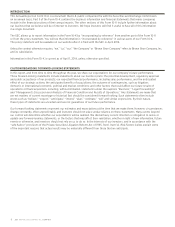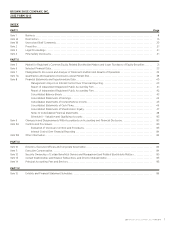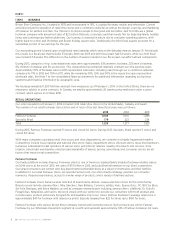Famous Footwear 2013 Annual Report Download - page 18
Download and view the complete annual report
Please find page 18 of the 2013 Famous Footwear annual report below. You can navigate through the pages in the report by either clicking on the pages listed below, or by using the keyword search tool below to find specific information within the annual report.16 2013 BROWN SHOE COMPANY, INC. FORM 10-K
manufacturers. Foreign sourcing is subject to numerous risks, including trade relations, work stoppages, disease
outbreaks, transportation delays and costs, political instability, foreign currency fluctuations, variable economic
conditions, expropriation, nationalization, natural disasters, terrorist acts and military conflict, and changes in
governmental regulations (including the U.S. Foreign Corrupt Practices Act and climate change legislation).
At the same time, potential changes in Chinese manufacturing preferences, including, but not limited to the
following, pose additional risk and uncertainty:
• Manufacturing capacity in China may shift from footwear to other industries with manufacturing margins
that are perceived to be higher.
• Growth in domestic footwear consumption in China could lead to a significant decrease in factory space
available for the manufacture of footwear to be exported.
• Some footwear manufacturers in China continue to face labor shortages as migrant workers seek better
wages and working conditions in other industries and locations.
As a result of these risks, there can be no assurance that we will not experience reductions in the available
production capacity, increases in our manufacturing costs, late deliveries, or terminations of our supplier
relationships. Furthermore these risks are compounded by the lack of diversification in the geographic location of
our foreign sourcing and manufacturing. With almost all of our supply originating in China, a substantial portion of
our supply could be at risk in the event of any significant negative development related to China.
Although we believe we could find alternative manufacturing sources for the products that we currently source from
China through other third-party manufacturing facilities in China or other countries, we may not be able to locate
alternative manufacturers on terms as favorable as our current terms, including pricing, payment terms, manufacturing
capacity, quality standards, and lead times for delivery. In addition, there is substantial competition in the footwear
industry for quality footwear manufacturers. Accordingly, our future results will partly depend on our ability to maintain
positive working relationships with, and oer competitive terms to, our foreign manufacturers. If supply issues cause us
to be unable to provide products consistent with our standards or manufacture our footwear in a cost and time ecient
manner, our customers may cancel orders, refuse to accept deliveries or demand reductions in purchase prices, any of
which could have a material adverse eect on our business and results of operations.
A cybersecurity breach may adversely aect our sales and reputation.
We routinely possess sensitive consumer and associate information. We also provide certain customer and employee
data to third parties for analysis, benefit distribution, or compliance purposes. While we believe we have taken
reasonable and appropriate steps to protect that information, hackers and data thieves operate sophisticated, large
scale attacks that could breach our information systems, despite ongoing security measures. In addition, we are
required to comply with increasingly complex regulations designed to protect our business and personal data.
Any breach of our network security, a third-party’s network security or failure to comply with applicable regulations
may result in (a) the loss of valuable business data and/or our consumers’ or associates’ personal information,
(b) increased costs associated with implementing additional protections and processes, (c) a disruption of our
business and a loss of sales, (d) negative media attention, (e) damage to our consumer and associate relationships
and reputation, and (f) fines or lawsuits.
We are reliant upon our information technology systems, and any major disruption of these systems could adversely
impact our ability to eectively operate our business.
Our computer network and systems are essential to all aspects of our operations, including design, pricing, production,
forecasting, ordering, manufacturing, transportation, sales, and distribution. Our ability to manage and maintain our
inventory and to deliver products in a timely manner depends on these systems. If any of these systems fails to operate
as expected, we experience problems with transitioning to upgraded or replacement systems, a breach in security occurs,
or a natural disaster interrupts system functions, we may experience delays in product fulfillment and reduced eciency
in our operations or be required to expend significant capital to correct the problem, which may have an adverse eect on
our results of operations and financial condition.
Customer concentration and other trends in customer behavior may lead to a reduction in or loss of sales.
Our wholesale customers include national chains, department stores, mass merchandisers, independent retailers, online
retailers, and catalogs. Several of our customers operate multiple department store divisions. Furthermore, we often sell
multiple types of branded, licensed, and private-label footwear to these same customers. While we believe purchasing
decisions in many cases are made independently by the buyers and merchandisers of each of the customers, a decision
by a significant customer to decrease the amount of footwear products purchased from us could have a material adverse
eect on our business, financial condition, or results of operations.
























